|
|
|
Sort Order |
|
|
|
Items / Page
|
|
|
|
|
|
|
| Srl | Item |
| 1 |
ID:
001718


|
|
|
|
|
| Publication |
Dordrecht, Kluwer academic publishers, 1997.
|
| Description |
xx,362p.Hbk
|
| Standard Number |
0792346505
|
|
|
|
|
|
|
|
|
|
|
|
Copies: C:1/I:0,R:0,Q:0
Circulation
| Accession# | Call# | Current Location | Status | Policy | Location |
| 041163 | 629.2934/MER 041163 | Main | On Shelf | General | |
|
|
|
|
| 2 |
ID:
051513
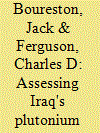

|
|
|
| 3 |
ID:
107892
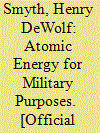

|
|
|
|
|
| Publication |
Princeton, Princeton University Press, 1948.
|
| Description |
vii, 308p.Hbk
|
|
|
|
|
|
|
|
|
|
|
|
Copies: C:1/I:0,R:0,Q:0
Circulation
| Accession# | Call# | Current Location | Status | Policy | Location |
| 003721 | 623.45119/SMY 003721 | Main | On Shelf | General | |
|
|
|
|
| 4 |
ID:
038314
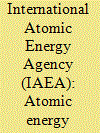

|
|
|
|
|
| Publication |
Vienna, International Atomic Energy Agency, 1966.
|
| Description |
112p
|
|
|
|
|
|
|
|
|
|
|
|
Copies: C:1/I:0,R:0,Q:0
Circulation
| Accession# | Call# | Current Location | Status | Policy | Location |
| 016671 | 546.434/INT 016671 | Main | On Shelf | General | |
|
|
|
|
| 5 |
ID:
056201
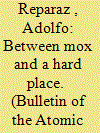

|
|
|
| 6 |
ID:
127633
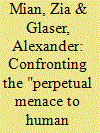

|
|
|
|
|
| Publication |
2014.
|
| Summary/Abstract |
Nuclear weapon states historically have attached great secrecy to their nuclear weapon and fissile material production programs and stockpiles, despite warnings that this would fuel fears, handicap informed debate and decision making, and drive arms races. As evidenced by the "Action Plan on Nuclear Disarmament" agreed upon at the 2010 Treaty on the Non-Proliferation of Nuclear Weapons (NPT) Review Conference, however, the international community now sees greater transparency about nuclear weapon and fissile material stocks as necessary for enabling and monitoring progress toward nuclear disarmament. To support this effort, the International Panel on Fissile Materials has proposed a step-by-step program for weapon states to declare their inventories, production histories, and disposition of nuclear warheads and fissile materials, and to set up joint projects to develop methods for verifying these declarations. This openness initiative is described here, and could be adopted at the 2015 NPT Review Conference, laying a basis for negotiating verifiable deep reductions in nuclear arsenals and their eventual elimination.
|
|
|
|
|
|
|
|
|
|
|
|
|
|
|
|
| 7 |
ID:
104158
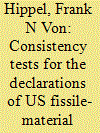

|
|
|
|
|
| Publication |
2011.
|
| Summary/Abstract |
In the 1970s and early 1980s, the United States Government released data on the history of its purchases of natural uranium, the amount of separative work done by U.S. uranium enrichment plants, and the fission energy released by U.S. production reactors. These data provided the basis of nongovernmental estimates in the 1980s of U.S. production of plutonium and highly enriched uranium. In 1996 and 2006, the United States published reports on its historical production of plutonium and highly enriched uranium respectively. This article presents a first rough analysis of the two sets of data and finds that they are reasonably consistent.
|
|
|
|
|
|
|
|
|
|
|
|
|
|
|
|
| 8 |
ID:
100137
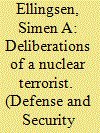

|
|
|
| 9 |
ID:
072884


|
|
|
|
|
| Publication |
2005.
|
| Summary/Abstract |
The United States has multiple nuclear detection initiatives to secure against a terrorist nuclear attack, including the Container Security Initiative, installation of radiation detectors at U.S. border points of entry, and establishment of the Domestic Nuclear Detection Office (DNDO). The current nuclear detection system architecture falls short of being able to reliably catch fissile nuclear material in transit, specifically shielded Highly Enriched Uranium (HEU) and Plutonium (Pu), both within the US and abroad. Checkpoints at border crossings can be circumvented, and no adequate system is under development to deter the transport of fissile materials. Using nuclear link-budget calculations, we show why a network relying primarily on handhelds, fixed detectors, and portals is not sufficient. We examine the technical, economic, and operational feasibility of a comprehensive national network incorporating in-vehicle detectors to reliably detect and deter the transport of fissile material inside the vehicle itself.
|
|
|
|
|
|
|
|
|
|
|
|
|
|
|
|
| 10 |
ID:
000959
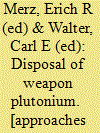

|
|
|
|
|
| Publication |
Dordrecht, Kluwer academic publishers, 1996.
|
| Description |
xx, 339p.
|
| Standard Number |
0792338413
|
|
|
|
|
|
|
|
|
|
|
|
Copies: C:1/I:0,R:0,Q:0
Circulation
| Accession# | Call# | Current Location | Status | Policy | Location |
| 038684 | 338.4762148335/MER 038684 | Main | On Shelf | General | |
|
|
|
|
| 11 |
ID:
011279
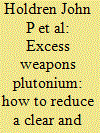

|
|
|
|
|
| Publication |
Nov-Dec 1996.
|
| Description |
3-9
|
|
|
|
|
|
|
|
|
|
|
|
|
|
|
|
| 12 |
ID:
092920
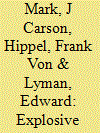

|
|
|
|
|
| Publication |
2009.
|
| Summary/Abstract |
The following discussion focuses on the question of whether a terrorist organization or a threshold state could make use of plutonium recovered from light-water-reactor fuel to construct a nuclear explosive device having a significantly damaging yield. Questions persist in some nonproliferation policy circles as to whether a bomb could be made from reactor-grade plutonium of high burn-up, and if so, whether the task would be too difficult for a threshold state or terrorist group to consider. Although the information relevant to these questions is in the public domain, and has been for a considerable time, it is assembled here for use by policy makers and members of the public who are concerned about preventing the spread of nuclear explosives.
|
|
|
|
|
|
|
|
|
|
|
|
|
|
|
|
| 13 |
ID:
111133
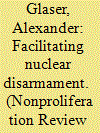

|
|
|
|
|
| Publication |
2012.
|
| Summary/Abstract |
Unprecedented interest in seeking progress toward nuclear disarmament exists today; even some nuclear weapon states are looking for new ways to strengthen this process. National declarations of fissile material holdings-highly enriched uranium and plutonium-could play an important role in supporting this effort, facilitating not only transparency but also the irreversibility of the process. This article discusses what kind of content such declarations could have in order to be meaningful and effective, the sequence of data on fissile material holdings that states might release, and some of the challenges to be expected in reconstructing historic fissile material production; it also summarizes current attitudes of weapon states toward making such declarations. Initial declarations can be valuable as confidence-building measures, but better and more background data are necessary if declarations are to serve as the groundwork for deeper cuts in the nuclear arsenals. A robust verification approach would ultimately require inspectors to have access to fissile material production and storage sites. The methods and tools of nuclear forensic analysis-in this context also dubbed nuclear archaeology-would be a key element of this process. This article discusses the capabilities and limitations of potential approaches to verifying declarations of historic production of plutonium and highly enriched uranium; it also identifies and discusses opportunities for further research and development.
|
|
|
|
|
|
|
|
|
|
|
|
|
|
|
|
| 14 |
ID:
085059
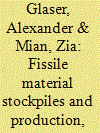

|
|
|
|
|
| Publication |
2008.
|
| Summary/Abstract |
This article presents estimates of global and national stockpiles of highly enriched uranium and separated plutonium based on the 2008 Global Fissile Material Report by the International Panel on Fissile Materials.1 The global stockpile of highly enriched uranium (HEU) is estimated to be 1670 ± 300 tons. It is declining as Russia and the United States blend down about 40 tons per year of HEU for use in light-water power-reactor fuel. This rate of blend-down is far higher than the estimated rate of production of HEU, currently believed to be limited to production by Pakistan for weapons and by India for naval fuel. The global stockpile of separated plutonium, all of which can be used for weapons, is about 500 tons. About half of this stockpile is civilian and is currently growing at less than 5 tons a year. This rate will increase significantly once Japan's Rokkasho reprocessing plant begins commercial operation. Only India and Pakistan and perhaps Israel are believed to be producing plutonium for weapons, at a combined rate of less than 60 kg per year. The United States and Russia have declared as excess to weapons requirements or for all military purposes a significant fraction of their stocks of both highly enriched uranium and plutonium produced for weapons. The United States and Russia continue to blend down the 210 and 500 tons, respectively, of HEU that they have declared excess to produce low-enriched uranium to fuel light-water reactors. The United States and Russia have yet to put in place the infrastructure to eliminate the 34 tons of excess weapons plutonium each committed to dispose under the 2000 U.S.-Russian Plutonium Management and Disposition Agreement. The past two years have also seen plans for new civilian enrichment plants and progress on new reprocessing plants. During this time, some former production facilities have been shut down, others dismantled, and in some cases key components have been demolished.
|
|
|
|
|
|
|
|
|
|
|
|
|
|
|
|
| 15 |
ID:
068702
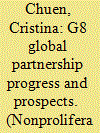

|
|
|
| 16 |
ID:
114438
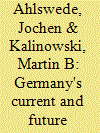

|
|
|
|
|
| Publication |
2012.
|
| Summary/Abstract |
In the past, Germany reprocessed a significant amount of its spent nuclear fuel, partly on its own territory but mostly as a customer of British and French reprocessing plants. In mid-2005, Germany stopped this practice, banning new transports of spent fuel for reprocessing-although the already-exported material would be allowed to be reprocessed and recycled in German reactors as mixed-oxide (MOX) fuel. In total, about 6,500 tonnes of heavy metal have been contracted for reprocessing, but a significant portion of this material has neither been reprocessed nor recycled as MOX fuel in German reactors. Due to the complex import-export history and the partly nontransparent information policy of the German government and utilities, a comprehensive and up-to-date plutonium balance for Germany is not publicly available. This report provides an assessment of Germany's plutonium inventory (stored domestically or abroad) based on open-source information. Special attention is paid to the issue of whether the entire inventory of separated plutonium can be completely irradiated in German nuclear reactors before the last of them are shut down in 2022. The authors conclude that Germany's stock of plutonium waiting to be recycled was about 12.2 tonnes as of 2010; this plutonium should be completely re-imported from the United Kingdom and France by 2017. Germany's MOX-consumption capacities should be sufficient to irradiate the remaining plutonium, although further delays are expected that could leave Germany with an inventory of separated (unirradiated) plutonium.
|
|
|
|
|
|
|
|
|
|
|
|
|
|
|
|
| 17 |
ID:
156583
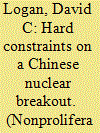

|
|
|
|
|
| Summary/Abstract |
Arguments about China's nuclear-modernization program and its implications for US nuclear policy rest on a fundamental misunderstanding. American experts have resurrected fears of a Chinese nuclear “breakout”—defined here as either development of a nuclear-warfighting capability or a significant and rapid increase in the scale of China's nuclear arsenal—to justify significant changes to US nuclear policies. In addition to the “soft” political constraints on China's nuclear arsenal, Beijing also faces a number of “hard” technical constraints, especially on a “sprint to parity” with the United States and Russia. A Chinese nuclear breakout would require significant changes to China's nuclear infrastructure that are likely to be highly detectable. The United States, while being vigilant for indications of a future Chinese nuclear breakout, should also adopt policies that decrease the likelihood of such changes.
|
|
|
|
|
|
|
|
|
|
|
|
|
|
|
|
| 18 |
ID:
167796
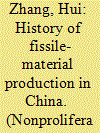

|
|
|
|
|
| Summary/Abstract |
This article reconstructs the history of China’s production of highly enriched uranium and plutonium for nuclear weapons based on newly available public sources. It begins with discussion of China’s first set of fissile-material production facilities, which China started building in 1958. It then details the first and second “third-line” construction campaigns, initiated in 1964 and the late 1960s, respectively. Finally, the article considers the policy implications of the history of China’s fissile-material production, particularly its influence on China’s attitude toward negotiating a fissile-material cutoff treaty.
|
|
|
|
|
|
|
|
|
|
|
|
|
|
|
|
| 19 |
ID:
104160
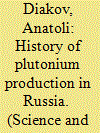

|
|
|
|
|
| Publication |
2011.
|
| Summary/Abstract |
For almost 50 years, the production and processing of weapon fissile materials was the primary mission of the Soviet nuclear complex. The cloak of secrecy on all nuclear weapons activities was lifted in 1995. However, the Soviet Union did not declare the amount of fissile-material that it produced for military purposes, and Russia did not reconsider the release of this information. Non-governmental analysts have made estimates of Russia's stocks of weapon-grade plutonium based on assumptions about the power history of the production rectors but such estimates are uncertain. This article attempts to provide improved estimates of production and current holding of weapons plutonium in Russia based on recent publications of historical documents and memoirs on the design and operation of the production reactors.
|
|
|
|
|
|
|
|
|
|
|
|
|
|
|
|
| 20 |
ID:
018550
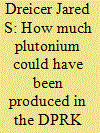

|
|
|
|
|
| Publication |
2000.
|
| Description |
315-328
|
|
|
|
|
|
|
|
|
|
|
|
|
|
|
|
|
|
|
|
|